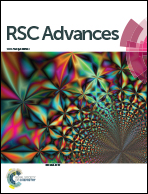Fast magnetic-field-induced formation of one-dimensional structured chain-like materials via sintering of Fe3O4/poly(styrene-co-n-butyl acrylate-co-acrylic acid) hybrid microspheres
Abstract
A facile and fast procedure has been developed to prepare one-dimensional (1D) hybrid microchains by sintering of Fe3O4/poly(styrene-co-n-butyl acrylate-co-acrylic acid) (Fe3O4/P(St-co-nBA-co-AA)) hybrid microspheres. Noteworthily, it is the first time that the 1D structure has been linked and fixed via physical fusion instead of by a chemical method. The crucial process is to sinter the hybrid microspheres at the glass transition temperature (Tg) of P(St-co-nBA-co-AA) particles under a magnetic field. SEM, optical microscopy, EDS, XRD and FTIR have proved the successful fabrication of 1D Fe3O4/P(St-co-nBA-co-AA) hybrid microchains and the formation mechanism has been discussed. The 1D hybrid microchains have lengths of several hundred micrometers and diameters of 10–15 μm. A TGA measurement has indicated that the large proportion of fused polymer particles in the 1D structures reaches 64.5%. A VSM curve has shown that the saturation magnetization is 18.7 emu g−1, which is enough for the 1D microchains to be controlled and separated by the external magnetic field. Mercury intrusion porosimetry and a SEM image of the fractured 1D microchains have demonstrated that these microchains are porous. Moreover, it has been found that individual microchains can be obtained at a low concentration of Fe3O4 particles, otherwise aggregation occurs.


 Please wait while we load your content...
Please wait while we load your content...